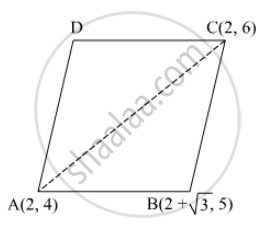Advertisements
Advertisements
Question
Find the area of a parallelogram ABCD if three of its vertices are A(2, 4), B(2 + \[\sqrt{3}\] , 5) and C(2, 6).
Solution
It is given that A(2, 4), B(2 + \[\sqrt{3}\] , 5) and C(2, 6) are the vertices of the parallelogram ABCD.

We know that the diagonal of a parallelogram divides it into two triangles having equal area.
∴ Area of the parallogram ABCD = 2 × Area of the ∆ABC
Now,
\[\text{ ar} \left( ∆ ABC \right) = \frac{1}{2}\left| x_1 \left( y_2 - y_3 \right) + x_2 \left( y_3 - y_1 \right) + x_3 \left( y_1 - y_2 \right) \right|\]
\[ = \frac{1}{2}\left| 2\left( 5 - 6 \right) + \left( 2 + \sqrt{3} \right)\left( 6 - 4 \right) + 2\left( 4 - 5 \right) \right|\]
\[ = \frac{1}{2}\left| - 2 + 4 + 2\sqrt{3} - 2 \right|\]
\[ = \frac{1}{2} \times 2\sqrt{3}\]
\[ = \sqrt{3}\text{ square units } \]
∴ Area of the parallogram ABCD = 2 × Area of the ∆ABC = 2 × \[\sqrt{3}\] = 2 \[\sqrt{3}\] square units
APPEARS IN
RELATED QUESTIONS
If (−2, 3), (4, −3) and (4, 5) are the mid-points of the sides of a triangle, find the coordinates of its centroid.
Find the points of trisection of the line segment joining the points:
(2, -2) and (-7, 4).
Find the coordinates of the point where the diagonals of the parallelogram formed by joining the points (-2, -1), (1, 0), (4, 3) and(1, 2) meet
In what ratio is the line segment joining (-3, -1) and (-8, -9) divided at the point (-5, -21/5)?
The line joining the points (2, 1) and (5, -8) is trisected at the points P and Q. If point P lies on the line 2x - y + k = 0. Find the value of k.
Find the coordinates of the midpoints of the line segment joining
A(3,0) and B(-5, 4)
Find the ratio in which the point P(m, 6) divides the join of A(-4, 3) and B(2, 8) Also, find the value of m.
If the points P (a,-11) , Q (5,b) ,R (2,15) and S (1,1). are the vertices of a parallelogram PQRS, find the values of a and b.
A point whose abscissa is −3 and ordinate 2 lies in
The distance of the point P (4, 3) from the origin is
The area of the triangle formed by the points A(2,0) B(6,0) and C(4,6) is
The points \[A \left( x_1 , y_1 \right) , B\left( x_2 , y_2 \right) , C\left( x_3 , y_3 \right)\] are the vertices of ΔABC .
(i) The median from A meets BC at D . Find the coordinates of the point D.
(ii) Find the coordinates of the point P on AD such that AP : PD = 2 : 1.
(iii) Find the points of coordinates Q and R on medians BE and CF respectively such thatBQ : QE = 2 : 1 and CR : RF = 2 : 1.
(iv) What are the coordinates of the centropid of the triangle ABC ?
Find the value of a for which the area of the triangle formed by the points A(a, 2a), B(−2, 6) and C(3, 1) is 10 square units.
Find the value(s) of k for which the points (3k − 1, k − 2), (k, k − 7) and (k − 1, −k − 2) are collinear.
If the points A(−2, 1), B(a, b) and C(4, −1) ae collinear and a − b = 1, find the values of aand b.
The line segment joining points (−3, −4), and (1, −2) is divided by y-axis in the ratio.
If the points P (x, y) is equidistant from A (5, 1) and B (−1, 5), then
If A(4, 9), B(2, 3) and C(6, 5) are the vertices of ∆ABC, then the length of median through C is
In which ratio the y-axis divides the line segment joining the points (5, – 6) and (–1, – 4)?
Assertion (A): Mid-point of a line segment divides the line segment in the ratio 1 : 1
Reason (R): The ratio in which the point (−3, k) divides the line segment joining the points (− 5, 4) and (− 2, 3) is 1 : 2.
